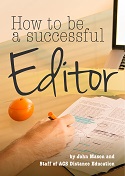Editing
 Editing is a specialised job. Some writers edit their own work, if they have the skill and training. Other writers depend upon contract or in house editors engaged by publishers.
Editing is a specialised job. Some writers edit their own work, if they have the skill and training. Other writers depend upon contract or in house editors engaged by publishers.
Editing is more than just correcting spelling mistakes and gramatical errors. It should always attend to these issues; but also to achieving a consistency in standard, presentation and style across a publication. Editors need to be meticulous, but not pedantic. They need to understand the needs of the publisher and writer who they work with, and appreciate the economic realities which affect what should be done to a piece of work.
Publications that generate greater income can afford the luxury of attempting near perfection, but those which are on a shoestring budget may in reality operate on the basis of tolerating a certain level of error. (eg. One magazine publisher told me that he does not start worrying until he receives the fifth complaint about errors in a single publication).
Distance Education Courses
Editing I (Click here to enrol)
Read below for a detailed course outline
- Editing II (Click here to enrol)
-
Seeking Work as an Editor
Editors are not only employed in newspapers and magazines. Many book publishersemploy full or part time editors. Some outsource work to editors who work from home.
Contract Editors are people who establish themselves as a small business, editing anything and everything that comes their way. This might include advertising literature for local companies, reports for businesses or private individuals, submission documents (eg. submitting for government approval on something), or books being written by a freelance author.
Contract editors may develop a network of opportunities by joining professional writing, publishing, editing or business associations; or they might advertise (eg. Editors often advertise in Writers magazines or journals).
Outline for EDITING I Course - BWR106
Duration: 100 Hours (you study at your own pace).
COURSE AIMS
- To gain an understanding of the role and scope of editing.
- Understand the importance of clear, effective writing throughout all stages of the publishing process.
- Describe the procedure of manuscript assessment.
- Describe the procedures used by copy editors.
- Explain procedures used to prepare copy for printing.
- Describe the checks and procedures used in the final stages of preparing and printing publications.
COURSE STRUCTURE
- 1.Introduction to Editing – the role and scope of editing; tools for editing; editing
- skills; the production process: an overview; who does what in publishing
- 2.The Mechanics of Clear Writing – spelling, punctuation, grammar, language;
- style; tense
- 3. Assessing Manuscripts – readability; word length; structure; consistencies and
- inaccuracies; the reader’s report; substantive editing; the author’s
- responsibilities; the author/editor relationship
- 4. Copy Editing I – what the copy editor does; the procedure; house style;
- style sheets
- 5. Copy Editing II – marking up; parts of a publication; editing non-text material;
- illustrations
- 6. Preparing Copy for Printing – type design and page layout; proof stages
- 7. Proof Reading
- 8.The Final Stages – indexes; blurbs; checking final proofs
[14/12/2025 21:00:13]